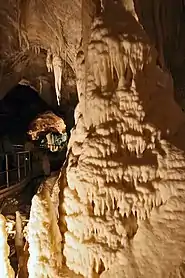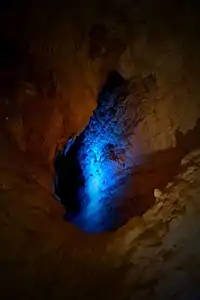| Grotte di Frasassi (Frasassi Caves) | |
|---|---|
 View of the caves | |
 Location of the caves in Italy | |
| Location | Frasassi, Genga (AN, Marche, Italy) |
| Coordinates | 43°24′03″N 12°57′43″E / 43.40083°N 12.96194°E |
| Depth | 400 m |
| Elevation | 300 m |
| Discovery | 1971 |
| Geology | Karst cave |
| Entrances | 1 |
| Access | Public |
| Show cave opened | 1974[1] |
| Show cave length | 5,000 m |
| Website | Official website |

The Frasassi Caves (Italian: Grotte di Frasassi) are a karst cave system in the municipality of Genga, Italy, in the province of Ancona, Marche. They are among the most famous show caves in Italy.
History
The caves, discovered by a group of Ancona speleologists led by Giancarlo Cappanera on 25 September 1971,[2] are situated 7 kilometres (4 miles) south of Genga, near the civil parish of San Vittore and the Genga-San Vittore railway station (Rome-Ancona line).
Rich in water, the cave system is particularly well endowed with stalactites and stalagmites.[3]
Near the entrance to the caves are two sanctuary-chapels: one is the 1029 Santuario di Santa Maria infra Saxa (Sanctuary of Holy Mary under the Rock) and the second is an 1828 Neoclassical architecture formal temple, known as Tempietto del Valadier.
Chambers
The Frasassi cave system includes a number of named chambers, including the following:
- Grotta delle Nottole, or "Cave of the Bats", named for the large colony of bats that lives within.[3]
- Grotta Grande del Vento, or "Great Cave of the Wind", discovered in 1971, with approximately 13 kilometres (8.1 mi) of passageways.[3]
- Abisso Ancona, or "Ancona Abyss", a huge space around 180 x 120 meters wide and near 200m tall.[3]
- Sala delle Candeline, or "Room of the Candles", named for its plentiful stalagmites that resemble candles.[3]
- Sala dell'Infinito, or "Room of the Infinite", a tall chamber with massive speleothem columns supporting the roof.[3]
 "Organ pipes"
"Organ pipes" Water well
Water well
Scientific experiments
The cave has been used to conduct experiments in chronobiology. Among the cavers that have spent considerable amount of time inside the cave is the Italian sociologist Maurizio Montalbini, who died in 2009.
Sister caves
Frasassi is partnered with several sister caves[4] around the world:
See also
- List of caves
- List of caves in Italy
- Bochnia Salt Mine, southern Poland, central Europe
- Wieliczka Salt Mine, near Kraków in Poland, central Europe
- Khewra Salt Mine, in Punjab , Pakistan
- Kartchner Caverns State Park in Arizona, the United States
- Grand Roc in Savoie, France, southern Europe
- Salt Cathedral of Zipaquirá, in Zipaquirá, Cundinamarca, Colombia, South America
- Chełm Chalk Tunnels, Poland, central Europe
References
- ↑ (in Italian) History of Frasassi
- ↑ "Come fu scoperta la Grotta Grande del Vento di Frasassi". frasassigsm.it (in Italian).
- 1 2 3 4 5 6 Scheffel, Richard L.; Wernet, Susan J., eds. (1980). Natural Wonders of the World. United States of America: Reader's Digest Association, Inc. p. 149. ISBN 0-89577-087-3.
- ↑ Sister caves on frasassi.com Archived 2009-08-31 at the Wayback Machine
External links
- (in Italian and English) Grotte di Frasassi official site
- (in English) The story of the discovery of the Frasassi caves
- (in Italian) Frasassi Online